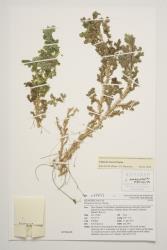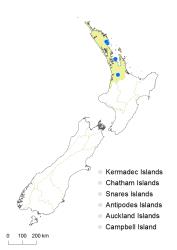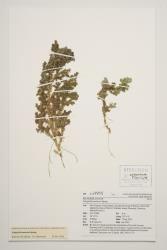Terrestrial plants. Stems far-creeping, up to 400 mm long, irregularly and abundantly branched with branches overlapping, prostrate to suberect, curling upwards in the distal half; stems yellow-brown proximally, green distally; longest branches 20–175 mm long. Roots arising from axils of branches, occurring in proximal half of the stems. Leaves spaced on creeping stems, but imbricate on ultimate branches, pale green proximally, dark green at branch apices, bases cordate, of two sizes; those in the two lateral rows larger, 3–4.5 mm long, 1.2–2.0 mm wide, spreading, ovate, apices acute to obtuse, bearing fine cilia on margins up to 0.3 mm long; those in the two upper rows smaller, 1.5–2.4 mm long, 0.8–1.3 mm wide, closely appressed to stem, ovate or elliptic, with a hair-point 0.6–1.0 mm long, bearing fine cilia on the margins. Strobili lateral on ultimate branches, sessile, 5–16 mm long, 1.8–3.0 mm diameter, round in cross-section, inconspicuous. Sporophylls similar to leaves of upper rows but slightly smaller with acuminate apices, 1.5–1.7 mm long, monomorphic, arranged in four ranks. Megaspores cream to white, with surface ridges forming 5–6-sided polygons. Microspores cream to buff, granulate to rugulate.
Selaginella martensii is similar to S. kraussiana, but distinguished by its suberect habit with the ultimate branches upturned in the distal half, and the roots produced only in the proximal half. Branching is more abundant in S. martensii, with branches regularly overlapping, whereas in S. kraussiana the branching is much more widely spaced. The leaf margins are finely ciliate in S. martensii but minutely toothed in S. kraussiana. Strobili are rarely seen outside cultivation. The microspores of S. martensii are granulate to rugulate and markedly different to the echinate microspores of S. kraussiana (Large & Braggins 1991, figs 49–57).
North Island: Northland, Auckland.
Altitudinal range: 10–40 m.
Collected from Whangārei, Waiheke Island and Hamilton as an escape from cultivation.
Occurs naturally in the highlands of Mexico and Central America (Mickel & Smith 2004).
Frequently cultivated in glasshouses and conservatories (Gardner 1995), and found on stream banks and in gullies and water-courses in broadleaved forest as an escape from cultivation.
Brownsey in Webb et al. (1988, p. 5, as an unknown species of Selaginella), later identified as S. martensii by Gardner (1995). Voucher AK 27111–271115, Whangārei Falls.






